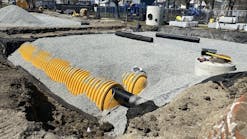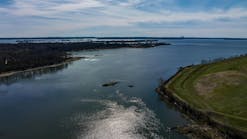The Segunda Descecha Canada Creek winds through the picturesque rolling hills and coastal valleys of Talega, Calif. for more than two miles near the Pacific Ocean.
Telega is a new community of about 3,500 acres and nearly 4,000 homes on the eastern edge of San Clemente, Calif. Limiting erosion of the creek stream bed to significantly increase the stability of the houses, roadways and bridges at the top of the hill was paramount (literally) for community leaders.
Without a flexible storm drain system, the community would have faced nearly double the runoff in the immediate area and potentially overwhelmed the downstream natural drainage facilities.
"Potential soil movement was the key factor in selecting a polyethylene (PE) pipe system," said James B. Yates, PE, senior project manager for Telega Associates. "The potential for differential settlement was a concern—we needed to maintain drainage all the way down the line."
Yates said geologists estimated that one to three inches of settlement could occur along the line, but that was within the tolerance of the PE pipe’s ability to deflect. The pipe has 75 elbows with bend angles between 11 degrees and 68 degrees.
The bypass storm drain system was installed directly adjacent to the creek and crosses the water in two locations. The amount of PE pipe used included:
_ 3,516 ft of 84-in. pipe;
_ 426 ft of 96-in. pipe;
_ 2,560 ft of 108-in. diameter pipe; and
_ 120 ft of 120-in. diameter pipe.
The increasing pipe sizes as the system moves downstream is typical with long storm drains as the system collects more water as it moves down.
"This system in Talega is one that demanded a flexible pipe," said Jeffrey Hiott, applications engineer for the Plastics Pipe Institute. "The terrain and the unique construction area for projects like this really show off what a polyethylene pipe system can mean to a community."
Consulting engineer Jeff Langdon, PE, agreed. He said polyethylene pipe was chosen "because of the long laying lengths that could be used in the tight construction area."
In many spots, the contractors could not work from the sides of the trench but rather from directly overhead.
"It was pretty tight, as narrow as 20 feet wide in areas," said Frank Robles, superintendent for Sukut Construction, of Santa Ana, Calif.. "The line is like a meandering walking trail. But the PE pipe is easy to handle due to its light weight and flexibility."
Because of the downstream and natural drainage limitations, seven detention basins were built along the creek with three on another tributary.
"We were able to lessen the major storm runoff flows to below pre-development levels," Yates said.
Source: PPI






